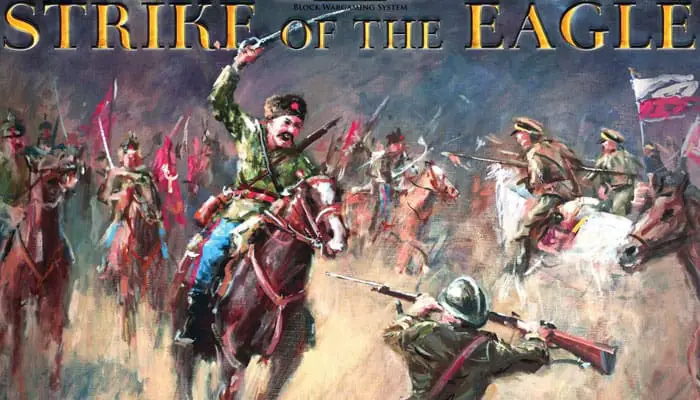The year is 1920. WWI has ended, but the battle for Europe has just begun. Trotsky, Lenin and Stalin plan to spread the workers' revolution by blasting through Poland in order to support the growing communist movements in Germany, France and Britain. Only the armies of Poland stand in the way of the Bolshevik tide.
Strike of the Eagle is a strategy game for 2 - 4 players that simulates the tenseness of the Polish-Soviet War of 1920. This war featured a return of sweeping cavalry attacks combined with innovative new weapons such as planes, tanks and armored cars.
Gone was the static trench warfare of WWI where front line changes were measured in yards. Instead, the gains of this war's campaigns were measured in
hundreds of miles from Kiev and beyond Minsk in the east, to Warsaw and the German border in the west.

Strike of the Eagle presents several scenarios highlighting crucial campaigns of the war. During the game, players use their armies to fight for objectives to gain victory points (VPs). The armies are composed of wooden blocks that represent Brigade and Division strength forces of between 1,500 to 8,000 men. Whichever side meets the scenario's victory conditions wins.
Scenarios last a varying number of rounds and each round is composed of 5 identical Operation Phases. The heart of this unique game lies in players placing secret orders on the map during each Operation Phase to bluff, mislead, misdirect and outplay their opponents.
The orders are then revealed and executed. Opposing blocks that end their movements in the same area initiate battle. After all five Operation Phases have been played, blocks are reinforced and a new round begins.

Critical decision making is required on how to best utilize the 6 cards each player receives at the beginning of each round.
Players must constantly weigh the pros and cons of their choices; use the cards to increase the number of orders they can issue, build up reinforcement resources, modify combat strengths, and much more.
Strike of the Eagle is a fast playing strategic game of constant action and critical decision making.
Charles S. Roberts Best Post-Napoleonic to Pre-World War 2 Era Board Wargame Nominee 2011






